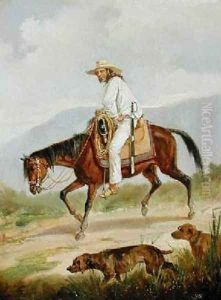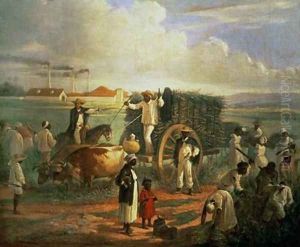Victor Patricio de Landaluze Paintings
Victor Patricio de Landaluze (1828–1889) was a Spanish-born artist who is most closely associated with Cuban colonial art and culture. Born in Bilbao, Spain, Landaluze moved to Cuba, where he spent the majority of his life and career, becoming one of the most significant figures in the island's art scene during the 19th century. His work provides a rich visual documentation of Cuban society, customs, and racial dynamics during a period of significant change and upheaval, including the struggle for independence from Spain.
Landaluze's oeuvre is notable for its genre paintings, illustrations, and caricatures that often depicted the daily life, festivities, and the diverse social strata of colonial Cuban society. He had a particular interest in the lives of Afro-Cubans and the various African influences on Cuban culture, which he portrayed with a mixture of affection, satire, and sometimes stereotypical exaggeration. His illustrations appeared in several periodicals of the time, contributing to the formation of Cuban national identity and offering insight into the complexities of colonial life.
Despite his European origin, Landaluze developed a deep connection with Cuban society, which is reflected in his work. However, his depictions of black and mixed-race Cubans have been the subject of scholarly debate, with some viewing his work as a critical commentary on slavery and racial hierarchies, while others argue that it reinforces racial stereotypes and colonial ideologies. Regardless of these debates, his art remains an invaluable source for understanding 19th-century Cuban society.
Landaluze's legacy is marked by his contribution to the visual arts and his role in documenting an era of Cuban history through his keen observational skills and distinctive artistic style. His works are preserved in various collections, both in Cuba and internationally, serving as a testament to his impact on the art and culture of his adopted homeland.

